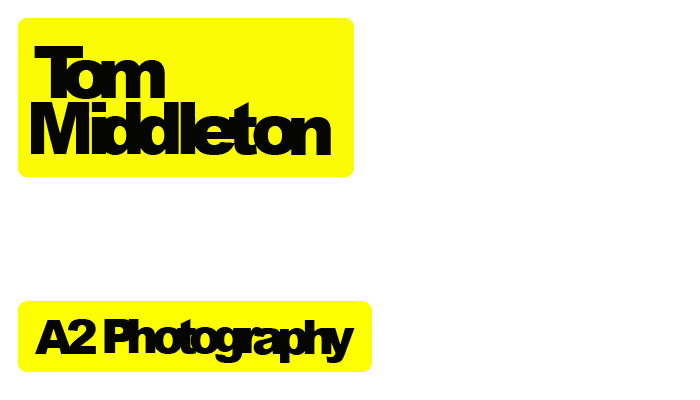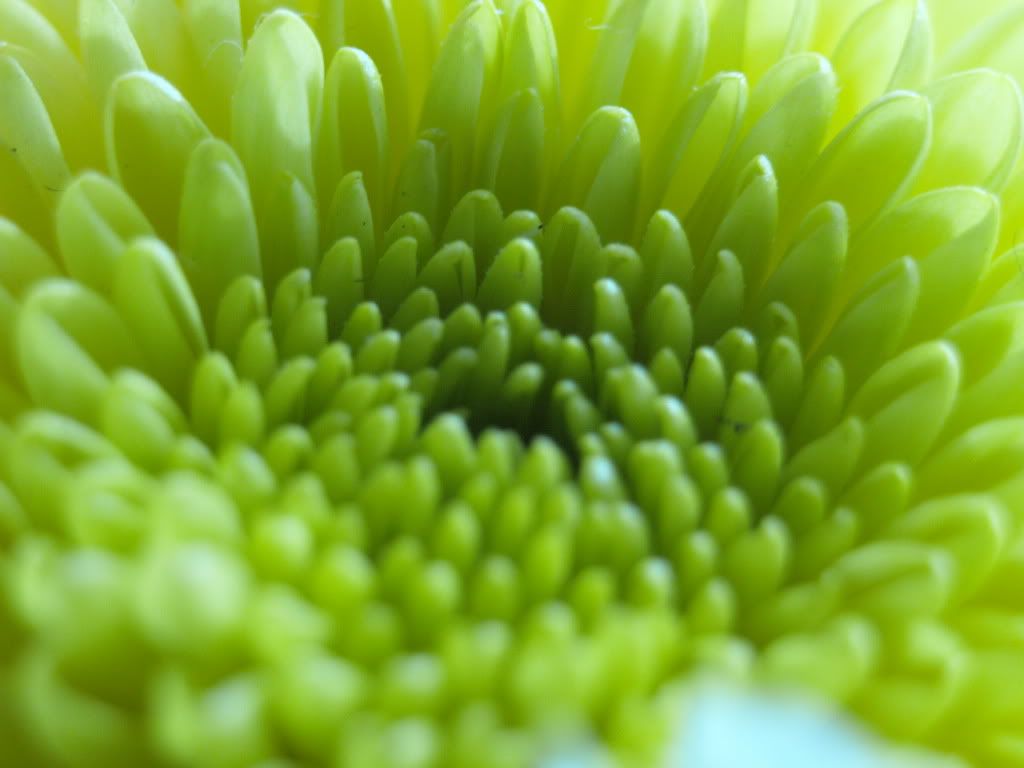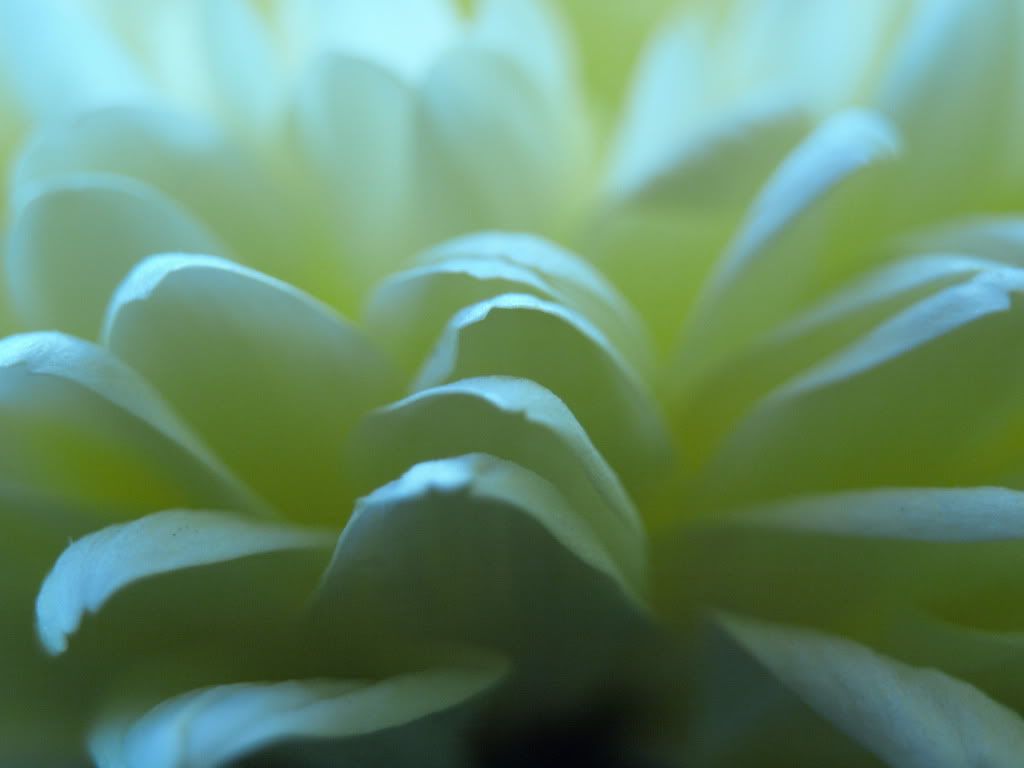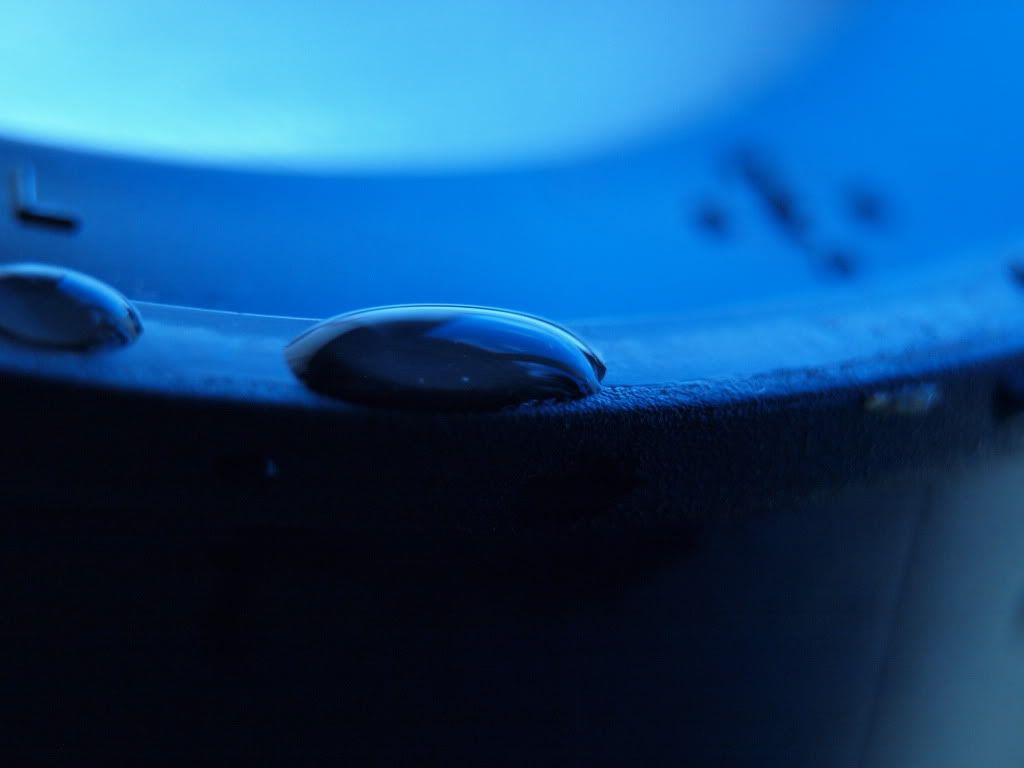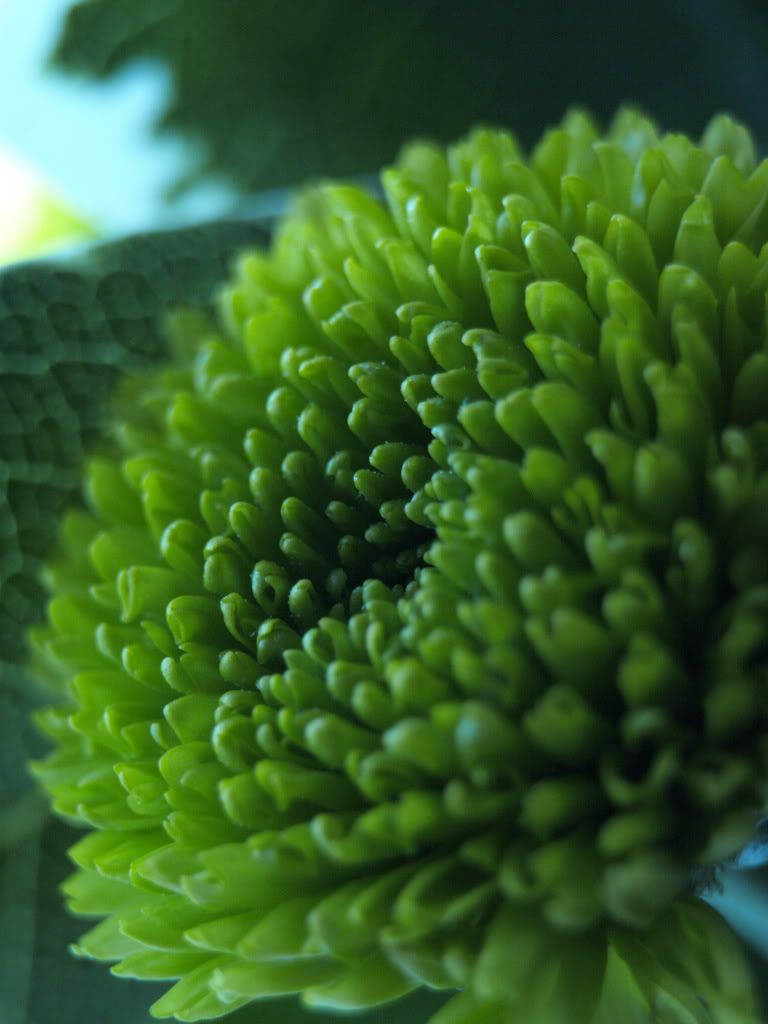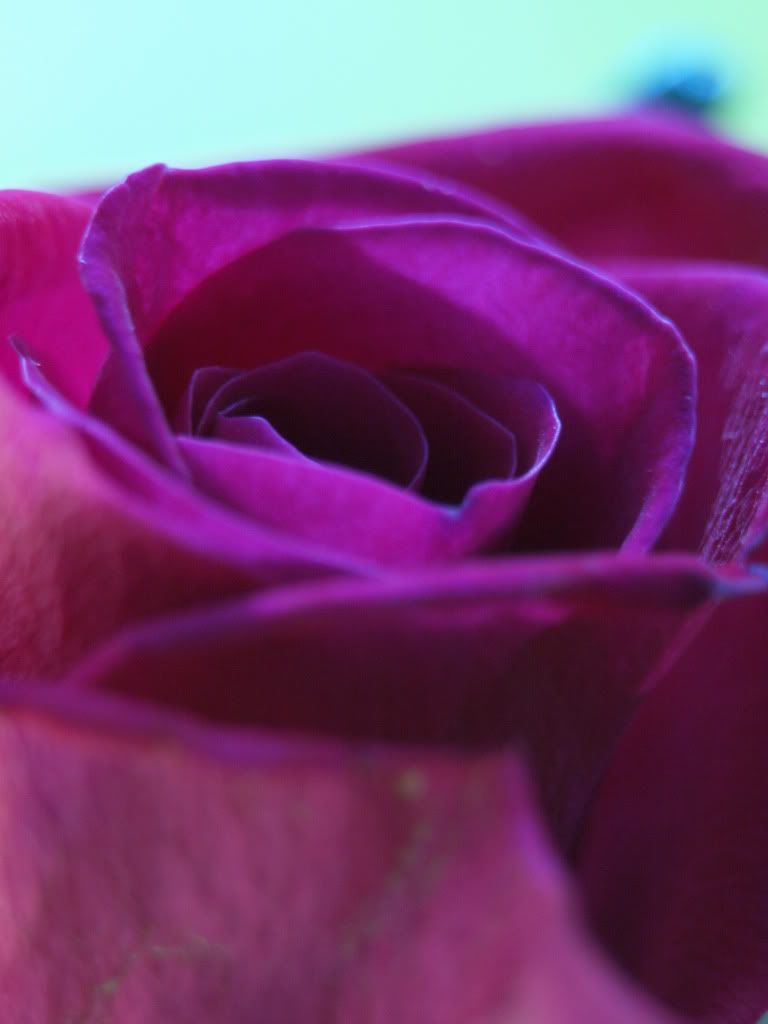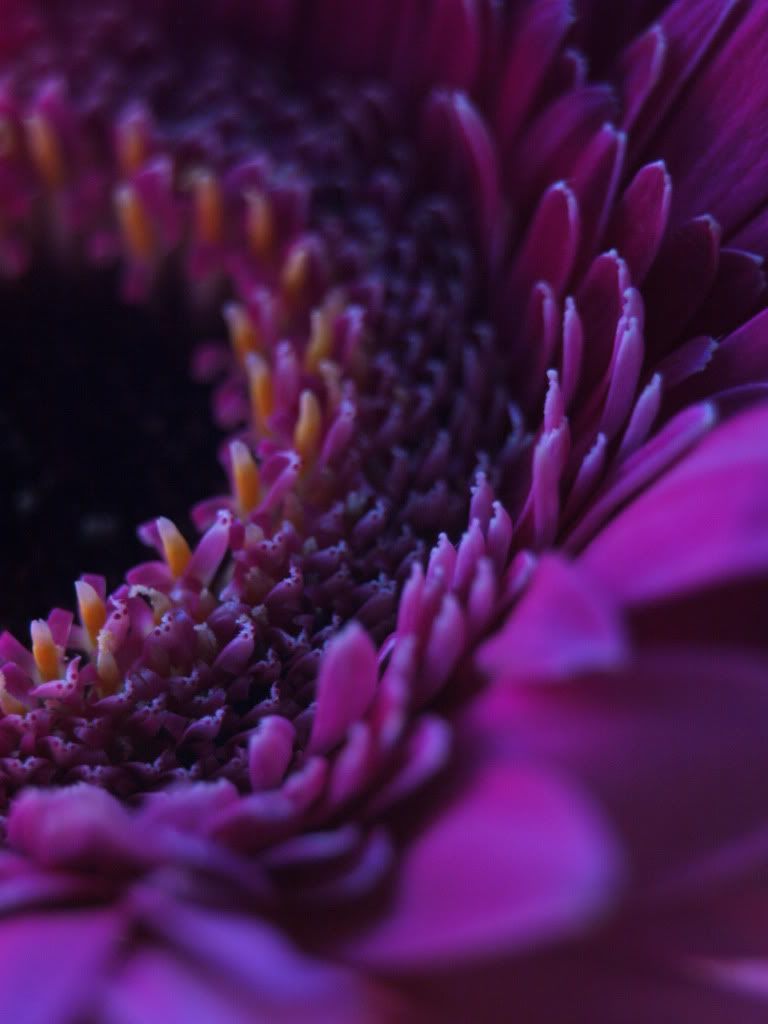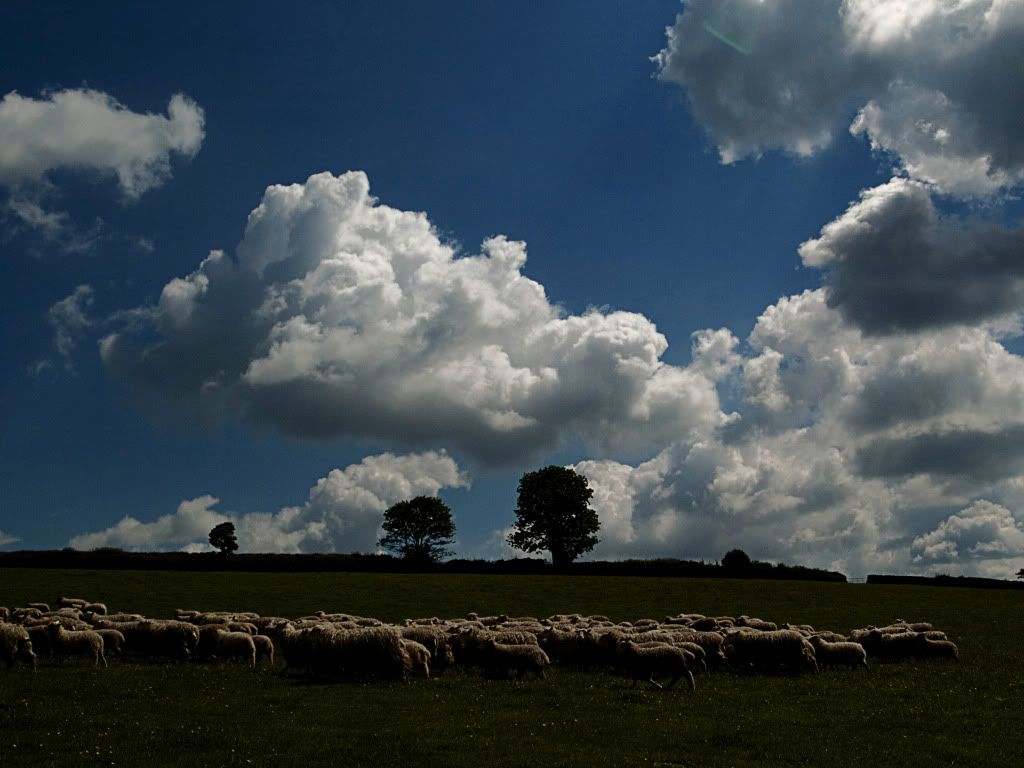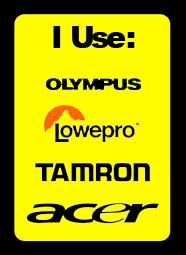Monday 29 March 2010
Final Piece Preparation
For my final piece I have decided to use what I have learnt so far from my portraits photography and produce a group of pictures of a single subject. I will use a variety of angles and I am hoping to use an interesting backdrop - such as a forest - rather than a simpler studio backing. Having seen what can be acheived with both natural and artificial lighting I will use a combination of both for my photos, mainly dependent on the conditions when I take the photographs. Due to the current weather artificial light maybe to needed, in which case I will opt for LED lights as they provide a more neutral blue light than say a tungsten bulb, which gives a very dominating but more intensive orange light. I will try and get some darker moodier photographs which can be aided by the weather. Using artificial light will allow for a lower ISO and a sharper photo will much less noise.
Monday 1 February 2010
Zooming In

I decided to experiment with styles and this is a technique that has been wildely used and experimented with. For this shot I used a slightly slower shutter speed and an ISO of roughly 400/800. By using a 40mm - 150mm lens I was able to zoom from around 55mm closer to 150mm whilst the photograph was being taken. I like the finished result although I decided to compare this image to what photoshop could acheive with the Radial Blur tool.

There is quite a difference between these two pictures. The one accomplished manually (top) with a camera zoom has far more highlighted streaks and there is much more clarity of the surroundings. The photoshop one (bottom) however has a consistant blur around the subject, possibly as depth of field affects blur focus on the camera shot. Overall I prefer the manually taken shot as it is less blurred and still retains a depth of field with identifiable features in the image.
Friday 29 January 2010
Macro Portraits
These portraits of the human eyes were acheived by using roughly 2.5" of macrotubes combined with a 150mm zoom lens. By using macrotubes the lens' zoom became the method for focusing.
Getting the focus correct on these photos required numerous attempts as the depth of field was so small. These two are part of a small group of images that came out with the focus in the correct place. I am very proud of how they came out, especially the brown eyed shot, as it is looking directly into the eye.


Natural Sunlight 3

This photo I took uses the sunlight to highlight one side of the face and throw the otherside into deep shadow. As this was candidI couldn't control the angle of the face although and I feel that if the subject was looking towards the camera the constrast would be more noticable. By using a large f/5.6 aperture a clear depth of field has been captured draw the viewer's attention to the face.
Natural Sunlight 2

This photo was taken at the same time as the previous shot but with the subject at a different angle. The skin looks paler and with the light coming from behind the subject there are slight shadows across the face, but instead of being a nuisance ot helps enhance the curvature and gradient of the face. The depth of field superbly highlights the face whilst throwing the background out of focus, greating a clear focal point.
Natural Sunlight

I took this photo using natural sunlight to provide the lighting. It was taken candidly and I think the end result is quite good. The orange sunset has complemented the complexion of the subject to provide a warm feeling to he photo. The light also provides some glint from the tinsel but not too much as to distract the eye.
Monday 7 December 2009
Outdoor Portraits Part 2
Having experimented with making my photos look like film photos I wanted to try a different approach.

Here is the original photo I took. It is quite well lit for the conditions I was using so I wanted to keep this aspect in the edited version.

I decided to do some of what I had done before in order to enhance the colours in the image. I did some tweaking of the levels, contrast and brightness. The result of this were much deeper and vivid colour tones. I again applied a vignette to darken the area surronding the subject. This has worked quite successfully I think, althouh it has darkened her face a little.

Here is the original photo I took. It is quite well lit for the conditions I was using so I wanted to keep this aspect in the edited version.

I decided to do some of what I had done before in order to enhance the colours in the image. I did some tweaking of the levels, contrast and brightness. The result of this were much deeper and vivid colour tones. I again applied a vignette to darken the area surronding the subject. This has worked quite successfully I think, althouh it has darkened her face a little.
Outdoor Portraits
I decided to take some outdoor photos before the winter weather took over. Luckily we got a break in the clouds and got some really bright winter sun. I experimented with the aperture, ISO and white balance to try and get some good shots in the changing conditions. I decided to use a cloudy white balance, an ISO of 400/800 and a F/5.6 aperture. I used this aperture to get a small depth of field focused around the subject. The ISO and white balance were selected to get a quick shutter speed and brighter colours.

This is one of my original photos from the shoot. As you can see it has a very monotonous background, and the subject is very windswept. I decided that for this shot I should use photoshop to alter it to make it seem less amateurish.

In this attempt I tried to make it look like a black and white photograph. I used photoshop to darken the shot and increase the contrast, I applied a vignette around the edges, added a grain texture and applied a black and white filter. I think this makes the image seem much older. The grain texture especially helps it look more like a film photo and the vignette helps to reduced the brightness of the background and helps to naturally increase the viewer's focus on the face. In a way this photo in reminiscent of Yousuf Karsh's work, of close portraits taken of the shoulders up.

This is one of my original photos from the shoot. As you can see it has a very monotonous background, and the subject is very windswept. I decided that for this shot I should use photoshop to alter it to make it seem less amateurish.

In this attempt I tried to make it look like a black and white photograph. I used photoshop to darken the shot and increase the contrast, I applied a vignette around the edges, added a grain texture and applied a black and white filter. I think this makes the image seem much older. The grain texture especially helps it look more like a film photo and the vignette helps to reduced the brightness of the background and helps to naturally increase the viewer's focus on the face. In a way this photo in reminiscent of Yousuf Karsh's work, of close portraits taken of the shoulders up.
Monday 16 November 2009
My 1st Attempt
Having looked at the work of people such as Andrew Zuckerman and Frans Lanting I decided to take some portrait photos of animals. I visited Paignton Zoo with my zoom lens and attempted to take some good photographs.

This photograph, taken of two Lions, I think is a good attempt to encompass the family ethic of these animals. I think I managed to frame this shot well, especially given the limited view points available. Unfortunately due to the layer of glass in between me and them the photo does not look as rich in colour as it could or as sharp. However I tried various angles and eventually I managed to get one that does not have any reflection or dirt from the surface of the glass.

This photo was quite a challenging shot to take. Visiting a zoo in early November provides a large number of challenges. Namely, for a lot of animals it was too cold and secondly the light quality it exceedingly poor. Luckily as we went into the Lemur enclosure one of them came down from sleeping in a tree and began jumping around the branches just above our heads. After a few minutes it came to rest on the handrail and stayed still, looking at the group of us taking photos. I managed to capture this image for the split second it was looking at me. After five minutes of frantic snapping we left and as we did the lemur ascended back into its tree. to take this photo I used 1/125th of a second at f/5.2. To increase the shutter speed I used an ISO 800. I really like this photo, as it captures the inquisitive face and nature of an animal that is usually very active.
 This is one of my favourite photographs of the day. Finding this adolescent cub lying right next to the fence, less then six feet from the camera was a real treat. Unfortunately the tiger never look at me, it was too preoccupied with a small child running around, but being able to get shots that filled the frame was brilliant. I wish the fence wasn't there but for safety reasons it is a necessity. Due to the face this area of the zoo was shrouded by trees I had to use ISO 400 with f/5.6 combined with 1/60th of a second. This means there is a small amount of motion blur on the whiskers but this is not very noticeable. By using a smaller aperture I was able to capture a smaller depth of field, meaning the face and and fence are in focus and the rest is out of focus and blurred.
This is one of my favourite photographs of the day. Finding this adolescent cub lying right next to the fence, less then six feet from the camera was a real treat. Unfortunately the tiger never look at me, it was too preoccupied with a small child running around, but being able to get shots that filled the frame was brilliant. I wish the fence wasn't there but for safety reasons it is a necessity. Due to the face this area of the zoo was shrouded by trees I had to use ISO 400 with f/5.6 combined with 1/60th of a second. This means there is a small amount of motion blur on the whiskers but this is not very noticeable. By using a smaller aperture I was able to capture a smaller depth of field, meaning the face and and fence are in focus and the rest is out of focus and blurred.

This photograph, taken of two Lions, I think is a good attempt to encompass the family ethic of these animals. I think I managed to frame this shot well, especially given the limited view points available. Unfortunately due to the layer of glass in between me and them the photo does not look as rich in colour as it could or as sharp. However I tried various angles and eventually I managed to get one that does not have any reflection or dirt from the surface of the glass.

This photo was quite a challenging shot to take. Visiting a zoo in early November provides a large number of challenges. Namely, for a lot of animals it was too cold and secondly the light quality it exceedingly poor. Luckily as we went into the Lemur enclosure one of them came down from sleeping in a tree and began jumping around the branches just above our heads. After a few minutes it came to rest on the handrail and stayed still, looking at the group of us taking photos. I managed to capture this image for the split second it was looking at me. After five minutes of frantic snapping we left and as we did the lemur ascended back into its tree. to take this photo I used 1/125th of a second at f/5.2. To increase the shutter speed I used an ISO 800. I really like this photo, as it captures the inquisitive face and nature of an animal that is usually very active.
 This is one of my favourite photographs of the day. Finding this adolescent cub lying right next to the fence, less then six feet from the camera was a real treat. Unfortunately the tiger never look at me, it was too preoccupied with a small child running around, but being able to get shots that filled the frame was brilliant. I wish the fence wasn't there but for safety reasons it is a necessity. Due to the face this area of the zoo was shrouded by trees I had to use ISO 400 with f/5.6 combined with 1/60th of a second. This means there is a small amount of motion blur on the whiskers but this is not very noticeable. By using a smaller aperture I was able to capture a smaller depth of field, meaning the face and and fence are in focus and the rest is out of focus and blurred.
This is one of my favourite photographs of the day. Finding this adolescent cub lying right next to the fence, less then six feet from the camera was a real treat. Unfortunately the tiger never look at me, it was too preoccupied with a small child running around, but being able to get shots that filled the frame was brilliant. I wish the fence wasn't there but for safety reasons it is a necessity. Due to the face this area of the zoo was shrouded by trees I had to use ISO 400 with f/5.6 combined with 1/60th of a second. This means there is a small amount of motion blur on the whiskers but this is not very noticeable. By using a smaller aperture I was able to capture a smaller depth of field, meaning the face and and fence are in focus and the rest is out of focus and blurred.
Andrew Zuckerman
Andrew Zuckerman is a distinguished animal photographer who varies from the normal approach of photographing animals by using a formally set up white background studio. This is remarkably different to the usual way of photographing animals in their natural habitat. His photos show the animals with much more clarity then any of the shots taken out in the wild. However this also adds a surrealist nature to the photos, due to the subdued colouring of the background.

This photograph is a good example of Zuckerman's work. It makes the animal seem simple and clearer. THe way the shot captures the elegance of the giraffe's neck as it leans back makes it seem just like a cresent shape against the background. The lighting here compliments the the skin tone of the animal, and makes it seem flat, with no texture.

Here, this photo captures the moment of the lions roar, something that has been photographed a lot of times. However the significant difference here is the studio background, which makes the image seem, to me, childish. I think this is because it reminds me of childhood photographs of lions in books, except in these the white background was added afterwards. This background changes make the image seem serious and scientific. Also, by getting rid of background colours and textures it seems as if there is more detail on the lion.

This photograph, taken of a hippo is quite an amusing photograph. It has been taken with the background and lighting as the giraffe and lion but because of its smiling face it seems humerous and friendly.

This photograph is a good example of Zuckerman's work. It makes the animal seem simple and clearer. THe way the shot captures the elegance of the giraffe's neck as it leans back makes it seem just like a cresent shape against the background. The lighting here compliments the the skin tone of the animal, and makes it seem flat, with no texture.

Here, this photo captures the moment of the lions roar, something that has been photographed a lot of times. However the significant difference here is the studio background, which makes the image seem, to me, childish. I think this is because it reminds me of childhood photographs of lions in books, except in these the white background was added afterwards. This background changes make the image seem serious and scientific. Also, by getting rid of background colours and textures it seems as if there is more detail on the lion.

This photograph, taken of a hippo is quite an amusing photograph. It has been taken with the background and lighting as the giraffe and lion but because of its smiling face it seems humerous and friendly.
Friday 13 November 2009
Frans Lanting
Lanting's work first caught my eye when I looked at his book 'Eye to Eye'. It contains many truly stunning photographs, including lots of portraiture of animal faces. He manages to effortless capture the subjects as if they were modelling for the camera. His manages as well to work with the natural surroundings to help enhance the details of the photo.

This photograph demonstrates well Lanting's ability to capture a shot of animals as if they were humans. This is an intimate shot of a these two cheetahs, capturing the idea that these are not just ruthless killers, but gentle family animals. The lighting in this photo is very natural, which in the case - with the prominent oranges and yellows - adds a warmth that a flash would take away. By using a zoom lens Lantings has accomplished two things. Firstly he has not disturbed the animal by being to close and secondly has a has got the depth of field spot on to clarify the subjects.

Here the photographer has managed to capture an animal that is usually constantly moving. He has used a flash do help to so but it is no to intrusive and obvious. I think this very similar to the photograph of the cheetahs in the way Lanting has captured the depth of field and the focus on the subject.

This photograph demonstrates well Lanting's ability to capture a shot of animals as if they were humans. This is an intimate shot of a these two cheetahs, capturing the idea that these are not just ruthless killers, but gentle family animals. The lighting in this photo is very natural, which in the case - with the prominent oranges and yellows - adds a warmth that a flash would take away. By using a zoom lens Lantings has accomplished two things. Firstly he has not disturbed the animal by being to close and secondly has a has got the depth of field spot on to clarify the subjects.

Here the photographer has managed to capture an animal that is usually constantly moving. He has used a flash do help to so but it is no to intrusive and obvious. I think this very similar to the photograph of the cheetahs in the way Lanting has captured the depth of field and the focus on the subject.
Monday 9 November 2009
Portraiture From a New Angle
Having said that I am going to look at portraits and close ups as my project I assumed this would be of people. However, I have realised that portraiture also covers such things as animals and pets. I have decided to analyse some portraits of animals - varying from domestic pets to slightly more exotic animals as would be found in zoos. Some notable photographers in this area are Frans Lanting and Andrew Zuckerman. Zuckerman in particular is noted for is work of studio photography of animals, which can compare well to human portraits.
Tuesday 3 November 2009
Yousuf Karsh
Yousuf Karsh was a Canadian photographer, famous for producing lots of iconic portrait photographs. His subjects included Humphrey Bogart, Winston Churchill, Nelson Mandella and Albert Einstein. He used primarily black and white for his images, utilizing it to create dark, atmospheric portrait shots that encapsulate the subject.

This portrait is rather straight forward and simple. The subject is centrally located, posed away from the camera with almost defensive body language. I think this has been done to show that Einstein was quite a unique and individual person. The lighting in this has been arranged to look very natural and soft, so it works well with the black and white format. Saying that, the lighting works well to highlight his face against the background.

This is quite an intimate shot of a very powerful figure. The head on aspect makes it seem very formal yet the smile and relaxed stance make it seem so much less informal than than the norm. The way the subject fills the image is very typical of a portrait - just capturing the shoulders and above. I think this is an excellent way of capturing the nature of the subject, through a mix of formal and casual styles.

This is a very iconic photograph of Humphrey Bogart was taken by Karsh in 1946. It has been seen as the distinctive image of Bogart and this highlights it's photographic significance. Karsh has executed a well though out portrait shot, capturing the essence of of Bogart's individual style. Karsh has used his skill in lighting yet again to provide superb illumination to the subject's facial features, without it being to harsh or with too much shadow. The pose of Bogart in this is one of an ordinary person, as if he is bringing himself to the viewer's level. The shot is well composed, filled by the subject but also his cigarette smoke, which adds character to photograph.

This portrait is rather straight forward and simple. The subject is centrally located, posed away from the camera with almost defensive body language. I think this has been done to show that Einstein was quite a unique and individual person. The lighting in this has been arranged to look very natural and soft, so it works well with the black and white format. Saying that, the lighting works well to highlight his face against the background.

This is quite an intimate shot of a very powerful figure. The head on aspect makes it seem very formal yet the smile and relaxed stance make it seem so much less informal than than the norm. The way the subject fills the image is very typical of a portrait - just capturing the shoulders and above. I think this is an excellent way of capturing the nature of the subject, through a mix of formal and casual styles.

This is a very iconic photograph of Humphrey Bogart was taken by Karsh in 1946. It has been seen as the distinctive image of Bogart and this highlights it's photographic significance. Karsh has executed a well though out portrait shot, capturing the essence of of Bogart's individual style. Karsh has used his skill in lighting yet again to provide superb illumination to the subject's facial features, without it being to harsh or with too much shadow. The pose of Bogart in this is one of an ordinary person, as if he is bringing himself to the viewer's level. The shot is well composed, filled by the subject but also his cigarette smoke, which adds character to photograph.
Thursday 22 October 2009
Tom Barnes
The work of Tom Barnes is very different to the work of the previous photographers I have looked at. He makes use of colour photography in addition to doing some much darker work. His work is mainly used for promotional material for bands and magazines. Compared to people such as Richard Avedon he makes much more use of studios and flashguns.

This photograph of a five piece band has been shot in a well lit studio location. It has been centred around the band singer, who is looking down towards the camera, generating a feeling of inferiority in the viewer. The poses of the two either side of him are quite open stances, with their bodies leaning in towards the singer. Those at the back are quite small in comparison to the front man, which demonstrates almost a hierarchy within the group. Barnes has made good use of a fill flash in this shot so that all the faces are well illuminated. The lighting in this photo has been excellently engineered to work out any shadow within the image.

This photograph is much darker compared to the previous photograph and uses very little colour. The enclose feeling generated by the small room and the crowded band has an intimate nature but at the same time there is that feeling of inferiority again. There is also more shadow in this image, especially around the singer's (again closest to the camera) face. The way those in the background have their sweatshirts open again promote a slightly less aggressive feeling, although the revealed t-shirts draw focus away from their faces due to the graphic nature of the designs. Due to the lack of colour it is less obvious the flash has been used but due to the brightness of the image for an enclosed space I would say that at least one has been used.

This photo is even darker and shadowier than before, again this one uses limited colours. The shadow in this means that the main focal point is are the faces of the band and the white parts of their clothing. The shadows cast on their face are quite striking and at the same time sinister. Once again Tom Barnes has positioned the camera low to get a shot looking upwards at the band.

This photograph of a five piece band has been shot in a well lit studio location. It has been centred around the band singer, who is looking down towards the camera, generating a feeling of inferiority in the viewer. The poses of the two either side of him are quite open stances, with their bodies leaning in towards the singer. Those at the back are quite small in comparison to the front man, which demonstrates almost a hierarchy within the group. Barnes has made good use of a fill flash in this shot so that all the faces are well illuminated. The lighting in this photo has been excellently engineered to work out any shadow within the image.

This photograph is much darker compared to the previous photograph and uses very little colour. The enclose feeling generated by the small room and the crowded band has an intimate nature but at the same time there is that feeling of inferiority again. There is also more shadow in this image, especially around the singer's (again closest to the camera) face. The way those in the background have their sweatshirts open again promote a slightly less aggressive feeling, although the revealed t-shirts draw focus away from their faces due to the graphic nature of the designs. Due to the lack of colour it is less obvious the flash has been used but due to the brightness of the image for an enclosed space I would say that at least one has been used.

This photo is even darker and shadowier than before, again this one uses limited colours. The shadow in this means that the main focal point is are the faces of the band and the white parts of their clothing. The shadows cast on their face are quite striking and at the same time sinister. Once again Tom Barnes has positioned the camera low to get a shot looking upwards at the band.
Thursday 15 October 2009
Gyula Halasz
Gyula Halasz's job and his love of the city, whose streets he often wandered late at night, led to photography. He later wrote that photography allowed him to seize the Paris night and the beauty of the streets and gardens, in rain and mist. Using the name of his birthplace, Gyula Halasz went by the pseudonym “Brassaï” . As Brassaï, he captured the essence of the city in his photographs, publishing his first book of photographs in 1933 titled “Paris de nuit” (“Paris by Night”). His efforts met with great success, resulting in his being called “the eye of Paris” in an essay by his friend Henry Miller. In addition to photos of the seedier side of Paris, he also provided scenes from the life of the city's high society, its intellectuals, its ballet, and the grand operas.

This photo was taken by Halasz in Paris and falls under the category of `candid photograph'. It is centred on the couple but also includes their reflection in the mirror behind them. The background is quite busy which in a formal portrait would be bad to have but as this is candid it is hard to avoid. However the reflecting of the couple in the mirror behind I find to be an interesting touch to this image.

This is a rather different portrait photograph is comparison to some of Halasz's work. The close proximity of the subject to the camera is striking and helps portray an image of age and wisdom. The lighting in this shot comes from the front and slightly to the left, putting some shadow in the palm of the hand. This has lighting has helped bring out the detail in the subject's face, especially in his wrinkles and his eyes. The overriding theme from this photograph seems to be that he is watching us, the eyes focused squarely on the photographer and the fingers wrapped around the eye - almost in such a way as to mimic a camera. The other hand placed as if propping up his head shows that he is almost bored of life and that it has grown to be predictable.

This photo was taken by Halasz in Paris and falls under the category of `candid photograph'. It is centred on the couple but also includes their reflection in the mirror behind them. The background is quite busy which in a formal portrait would be bad to have but as this is candid it is hard to avoid. However the reflecting of the couple in the mirror behind I find to be an interesting touch to this image.

This is a rather different portrait photograph is comparison to some of Halasz's work. The close proximity of the subject to the camera is striking and helps portray an image of age and wisdom. The lighting in this shot comes from the front and slightly to the left, putting some shadow in the palm of the hand. This has lighting has helped bring out the detail in the subject's face, especially in his wrinkles and his eyes. The overriding theme from this photograph seems to be that he is watching us, the eyes focused squarely on the photographer and the fingers wrapped around the eye - almost in such a way as to mimic a camera. The other hand placed as if propping up his head shows that he is almost bored of life and that it has grown to be predictable.
Tuesday 6 October 2009
Richard Avedon
In 1944, Richard Avedon began working as an advertising photographer for a department store, but was quickly discovered by Alexey Brodovitch, the art director for the fashion magazine Harper’s Bazaar. In 1946, Avedon had set up his own studio and began providing images for magazines including Vogue and Life.
As his reputation as a photographer became widely known, he brought in many famous faces to his studio and photographed them with a large-format 8x10 view camera. His portraits are easily distinguished by their minimalist style, where the person is looking squarely in the camera, posed in front of a sheer white background. He is also distinguished by his large prints, sometimes measuring over three feet in height.

This is a simple, formal photograph of Marilyn Monroe. The depth of field is good as the foreground is well focused on the subject and they background is out of focus. The plain background puts focus on the subject. The black and white aspect makes it seem more stylised and art, whereas colour might have made it look to busy, especially as it the subject is wearing a sparkly dress. As the subject is not looking at the camera it makes her look thoughtful and because the camera is on the same level, and a feeling of equality is established with this superstar.

This photograph is in a way very similar to that of Marilyn Monroe as above. It shares the same characteristics in terms of depth of field but also the plain background denotes almost a studio backdrop. I like the simplicity in the style of the photo combined with the 'complexity' of what is happening in the photograph, the man holding a decapitated snake and is covered in what looks like entrails. The large amounts of white in this photograph do well to contrast the dark skin tone of the snake.
As his reputation as a photographer became widely known, he brought in many famous faces to his studio and photographed them with a large-format 8x10 view camera. His portraits are easily distinguished by their minimalist style, where the person is looking squarely in the camera, posed in front of a sheer white background. He is also distinguished by his large prints, sometimes measuring over three feet in height.

This is a simple, formal photograph of Marilyn Monroe. The depth of field is good as the foreground is well focused on the subject and they background is out of focus. The plain background puts focus on the subject. The black and white aspect makes it seem more stylised and art, whereas colour might have made it look to busy, especially as it the subject is wearing a sparkly dress. As the subject is not looking at the camera it makes her look thoughtful and because the camera is on the same level, and a feeling of equality is established with this superstar.

This photograph is in a way very similar to that of Marilyn Monroe as above. It shares the same characteristics in terms of depth of field but also the plain background denotes almost a studio backdrop. I like the simplicity in the style of the photo combined with the 'complexity' of what is happening in the photograph, the man holding a decapitated snake and is covered in what looks like entrails. The large amounts of white in this photograph do well to contrast the dark skin tone of the snake.

This is different to the previous photographs and is much more striking in comparison. The bold pose struck between the two elephants, combined with the outfit seems to perfectly contrast the lives of oppression lead by the elephants who are chained to the floor. The elegant pose seems to be the opposite of the large, lumbering forms of the elephants. I feel this photo seems to talk about contradiction.
Tuesday 29 September 2009
Henri Cartier-Bresson
Henri Cartier Bresson was a French photographer whose main reclaim came from his photojournalistic work. His work was a good representation of "real life" photography and his candid portraiture is what I will primarily be looking at. He also produced many portrait photographs designed to look like candid shots that were actually posed. Some of his subjects included Richard Nixon, Gandhi and Coco Chanel.
 This candid photograph is I think well done as it is clearly focused on the pair of women, despite the busy background. This style of photograph typifies Bresson's work, espcially his candid photography. I like this shot as it gets across a message about the society at the time. For a candid shot the subjects are well positioned and also well lite, with the light catching the sides of their faces visible to the camera.
This candid photograph is I think well done as it is clearly focused on the pair of women, despite the busy background. This style of photograph typifies Bresson's work, espcially his candid photography. I like this shot as it gets across a message about the society at the time. For a candid shot the subjects are well positioned and also well lite, with the light catching the sides of their faces visible to the camera.
 This candid photograph is I think well done as it is clearly focused on the pair of women, despite the busy background. This style of photograph typifies Bresson's work, espcially his candid photography. I like this shot as it gets across a message about the society at the time. For a candid shot the subjects are well positioned and also well lite, with the light catching the sides of their faces visible to the camera.
This candid photograph is I think well done as it is clearly focused on the pair of women, despite the busy background. This style of photograph typifies Bresson's work, espcially his candid photography. I like this shot as it gets across a message about the society at the time. For a candid shot the subjects are well positioned and also well lite, with the light catching the sides of their faces visible to the camera.
This photography of Richard Nixon, taken by Bresson, is a fine example of his candid style 'posed' photography. The way the subject is positioned, with the natural light from the window falling directly on his face, is too perfect for a candid shot. The lighting does however mean that shadows are cast over the rest of his body, emphasing his facial features. Bresson's depth of field perfectly captures the office scene. With enough focus to clearly show the face but also enough to show that he is at work and what is on his desk.

This photograph is nice in the way that it displays the scene of military uniformity, but because of the little girl looking at the camera it makes political inferences, espcially towards the communistical regime of which the subjects are part of. As mentioned before the fact that the girl is looking towards the camera makes the scene look less surreal, as it break the uniformity of all the other subjects. The depth of field perfectly captures the girl and the man next to her looking at the camera. The graduated lack of focus on those in black the further away they are fits the photo perfectly, as it makes them seem to fade away.
Wednesday 23 September 2009
Portrait Photography
As I am going to do a portrait photography project I will look at the different styles and aspects of portraiture. I will look at the two main styles; candid and posed. For candid photography I will look at the work of photographers such as Henri Cartier-Bresson and Brassai who are two of the most renowned photographers of this genre. For posed photography I will look at some contemporary photographers such as Tom Barnes and Yousuf Karsh, who have two very different styles and approaches to this aspect of portraiture.
Wednesday 16 September 2009
A2 Project
Having looked at the various aspects of photography that I could use for my project I have decided to combine portrait photography and close up photography. I will use also photos of a candid nature and some taken in a studio setting. I think this will produce a varied group of images with contrasting light and shadow.
To help with this I will analyse the work of other photographers throughout the ages of photography. I will make comparisons between their work and my attempts to replicate their style of photography.
To help with this I will analyse the work of other photographers throughout the ages of photography. I will make comparisons between their work and my attempts to replicate their style of photography.
Thursday 27 August 2009
Summer Project
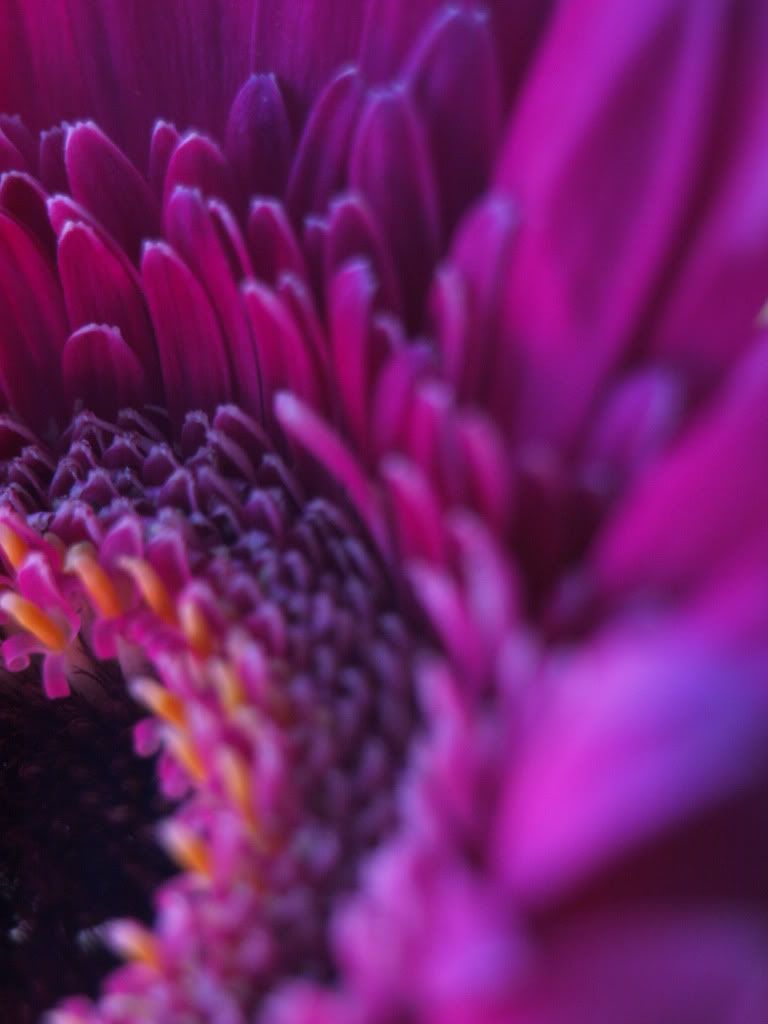


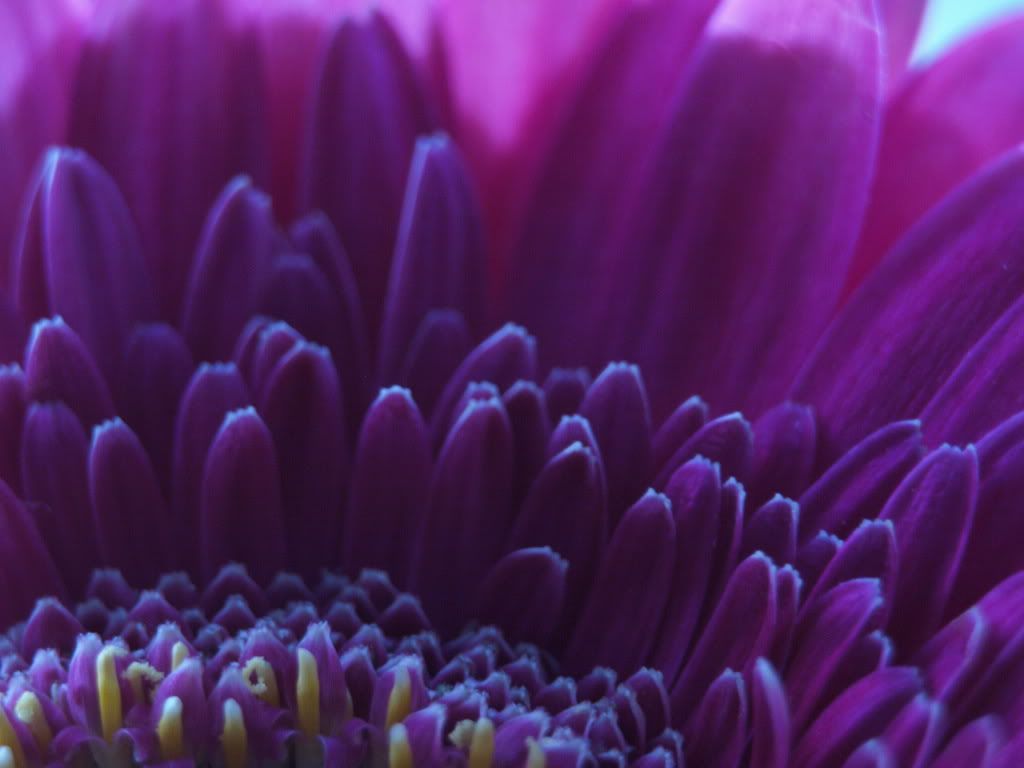

These photos are for my summer photography project. I decided to pick a theme of rather obvious nature and capitalize on the whole idea of sun and flowers. These photos were taken indoors by a window for optimum natural light. This photos have not been edited in Photoshop, although some could benefit from some tweaks to the levels. I enhanced my initial theme by taking macro photographs to capture the intricate pattern of the flower and petals. I used my Olypmus E410 with 2.5" of macro tubes with a 40mm - 150mm zoom lens and lens hood to cut down on glare.
Monday 20 July 2009
Macro

This is a macro shot I took using my 40mm - 150mm lens combined with 2" of macro tubes. I really like the depth of field in this shot. Because of the macro tubes, the focus could only be adjusted through increasing/decreasing the zoom or moving closer to the subject. Overall I am very happy with this attempt.
HDR
Thursday 11 June 2009
Successful Day Today
Just got back from an excellent photography workshop done by photographer Chris Chapman. He taught us some really useful stuff about aperture, shutter speed and RAW files. We then went around a farm taking pictures of various animals cows and sheep etc... Really good time, just a shame Harriet had to leave early, abandoning me on own, she's lovely though :). A final photoshopping session was very useful aswell. Photos from today will be up shortly.
Monday 8 June 2009
First few photo examples
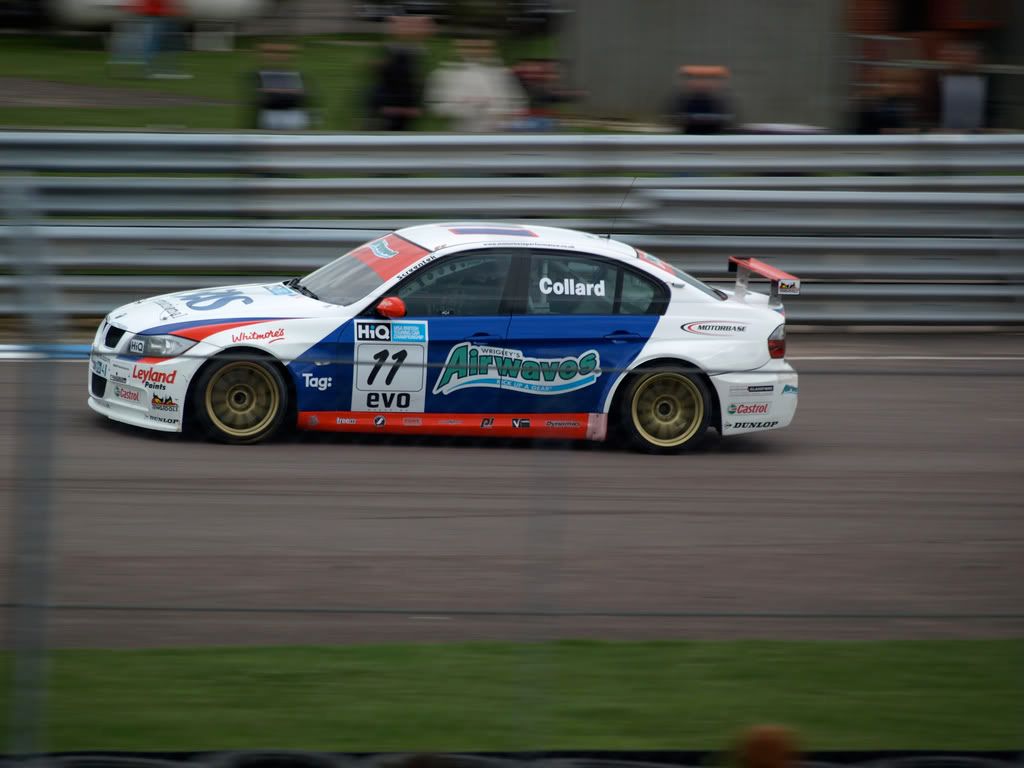
This photo shows a BMW touring car. I took this photo in April this year at Thruxton racing circuit. I used a panning technique to follow the car down the track, taking several images as I went. This was the best one from the particular set. Through panning I managed to capture the car in focus, despite the fence in the foreground. The weather conditions at the time required a longer shutter speed so more motion blur could be captured.
Introductions
Hi,
Im Tom, im 17 and from Christow in Devon. This blog has been set up as a way of displaying my work for my photography A2 course. I use an Olympus E410 with a 17.5mm - 55mm wide angle lens and and 40mm - 150mm telephoto lens. In the upcoming weeks i will publish more posts and photos. If you wish to see my current photos on the web then just follow this link - www.flickr.com/photos/tomteign (you might need to put it into your URL bar).
Im Tom, im 17 and from Christow in Devon. This blog has been set up as a way of displaying my work for my photography A2 course. I use an Olympus E410 with a 17.5mm - 55mm wide angle lens and and 40mm - 150mm telephoto lens. In the upcoming weeks i will publish more posts and photos. If you wish to see my current photos on the web then just follow this link - www.flickr.com/photos/tomteign (you might need to put it into your URL bar).
Subscribe to:
Posts (Atom)
